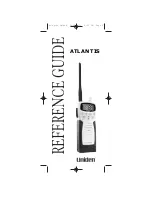
TK-373G
14
●
EEPROM
Note : The EEPROM stores tuning data (Deviation, Squelch,
etc.).
Realign the transceiver after replacing the EEPROM.
3) Low battery warning
The battery voltage is monitored by the microprocessor
(IC13). When the battery voltage falls below the voltage set
by the Low Battery Warning adjustment, the LED flashes
red to notify the operator that it is time to replace the battery.
If the battery voltage falls even more (approx. 5.8V), a beep
sounds and transmission is stopped.
CIRCUIT DESCRIPTION
Fig. 9 Memory circuit
IC13
IC12
CPU
IC10
EEPROM
FLASH
1) Frequency shift circuit
The microprocessor (IC13) operates at a clock of
9.8304MHz. This oscillator has a circuit that shifts the
frequency by BEAT SHIFT SW (Q31).
2) Memory circuit
Memory circuit consists of the CPU (IC13) and a flash
memory (IC12). A flash memory has a capacity of 2M bits
that contains the transceiver control program for the CPU
and data such as transceiver channels and operating
features.
This program can be easily written from an external device.
Data, such as DTMF memories and the operating status,
are programmed into the EEPROM (IC10).
●
Flash Memory
Note : The flash memory holds data such as written with the
FPU (KPG-76D) and firmware program (User mode, Test
mode, Tuning mode, etc.). This data must be rewritten when
replacing the flash memory.
Fig. 10 Control system
8. CONTROL SYSTEM
Keys and channel selector circuit.
The signal from keys and channel selector input to
microprocessor directly as shown in fig. 10.
Channel selector
IC13
CPU
CN501
CN1
EN1
87
3
25
EN3
EN2
KOUT0
KOUT1
KOUT2
KOUT3
KIN0
KIN1
KIN2
KIN3
KIN4
16
27
KEYAD
PTT
MONI
SW
LAMP
SW
PTT
SW
5M
47k
47k
100k
A
B
Low battery warning
The red LED flashes during
transmission.
The red LED flashes and a
continuous beep sounds
while PTT is pressed.
Battery condition
The battery voltage is low but
the transceiver is still usable.
The battery voltage is low and
the transceiver is not able to
make calls.















































